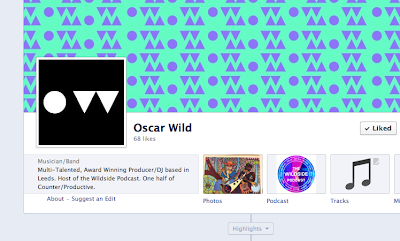29.5.13
2.5.13
30.4.13
glitchy
I've been experimenting with vinyl designs and made some interesting visuals. They're quite glitchy in appearance but it's appropriate to the electronic music scene. It fits in with how electronic music is made up of several elements. I like the juxtaposition of the shapes and the colours that sit harmoniously in the design. I put the imagery into the poster designs too but think i'll stick with the original designs in order to keep the clarity.
29.4.13
28.4.13
20.4.13
16.4.13
12.4.13
new colour scheme
After feedback and consideration I've decided to add colour to the designs as it fits in with the concept of visual sound. I think they work much better as the visual aesthetic is more appealing and conceptually fitting. The pantones i've gone for are:
green - c66m0y50k0
grey - c0m0y0k30
purple - c61m81y0k0
green - c66m0y50k0
grey - c0m0y0k30
purple - c61m81y0k0
11.4.13
10.4.13
copper
In order to draw people into the exhibition I've created a series of 3 posters, one of them being just image. That way it acts as a bit of a teaser making people curious to find out more. These are the designs I think I'll be going with as they work quite well in terms of composition and as a triptych.
5.4.13
30.3.13
25.3.13
wire development
The later designs are too busy with the wired type but i definitely feel like the original wired type works better. The copper wired visual works quite well in terms of an aesthetic for the brief. It's conceptual and stands out quite a lot from the page. I'll develop designs for this and see what more i can do with this.
23.3.13
22.3.13
poster development
Experimenting with poster visuals using the new wired effect. As a design i feel it looks to busy so i'll continue to play around image. I do however like the type on the poster but again i definitely needs refining.
20.3.13
visuals
I've been experimenting with visuals, which have been inspired by the electronics behind the machines that create electronic music. I wanted to use this imagery to create a identity for the exhibition and use experimental type for the Oramics to Electronica. Using the effect of wiring i created this joined up type that could sit quite nicely on the posters...
15.3.13
brief 4
Brief
I've decided to bring together a brief consisting of a collection of identity/logo designs that I've been working on this year. Rather than doing them as separate briefs it makes sense to bring them together.
They are four logo designs I've been and will be working on, three for music and one for fashion:
Oscar Wild - a music producer looking for a logo and an online presence.
Cirque Du Soul - identity for an upcoming house/funk night.
Option One - a new house night looking to set up after parties in order to get their name & logo recognized.
Fashion Show & Exhibition - looking for an identity / logo
I've decided to bring together a brief consisting of a collection of identity/logo designs that I've been working on this year. Rather than doing them as separate briefs it makes sense to bring them together.
They are four logo designs I've been and will be working on, three for music and one for fashion:
Oscar Wild - a music producer looking for a logo and an online presence.
Cirque Du Soul - identity for an upcoming house/funk night.
Option One - a new house night looking to set up after parties in order to get their name & logo recognized.
Fashion Show & Exhibition - looking for an identity / logo
image
Experimenting with some visuals and layout for the poster designs to see what i could potentially use for the aesthetic for the brief. Although i like the idea of using this sort of shape for the designs i feel there's a lot more potential and so more development is needed.
14.3.13
10.3.13
6.3.13
OBAFGKM
When looking at stellar classification, O B A F G K M, we need to obtain an example of a star for each category.
O
Class O stars are very hot and extremely luminous, being bluish in color. An example of this star category is Alpha Camelopardalis
Spectral Type: O9.5
Apparent Magnitude: 4.3 v
Distance: 6,000 ly
Mass: 43.2 solar mass
Radius: 36.8
Temperature: 27,700k
Age: 2 million years
Rotational Velocity: 80 km/s
B
Class B stars are very luminous and blue eg Rigel
Spectral Type: B8
Apparent Magnitude: 0.1 v
Distance: 772.9 ly
Mass: 18 solar mass
Radius: 74 r
Temperature: 12,130 k
Age: 8 million years
Rotational Velocity: 40 km/s
A
Class A stars are among the more common naked eye stars, and are white or bluish-white eg Sirius
Spectral Type: A1
Apparent Magnitude: -1.5 v
Distance: 8.6 ly
Mass: 2.0 solar mass
Radius: 1.7 r
Temperature: 9,940 k
Age: 250 million years
Rotational Velocity: 16 km/s
F
Class F stars are mostly white eg Polaris
Spectral Type: F7
Apparent Magnitude: 1.9 v
Distance: 433.8 ly
Mass: 4.5 solar mass
Radius: 46 r
Temperature: 6,015 k
Age: 70 million years
Rotational Velocity: 14 km/s
G
Class G stars are probably the best known, if only for the reason that the Sun is of this class eg Our Sun
Spectral Type: G2
Apparent Magnitude: -26.7 v
Distance: 8.3 minutes at light speed
Mass: 1 solar mass
Radius: 1 r
Temperature: 5,778 k
Age: 4.5 billion years
Rotational Velocity: 20 km/s
K
Class K are orangish stars that are slightly cooler than the Sun eg Arcturus
Spectral Type: K1.5
Apparent Magnitude: -2.3 v
Distance: 36.7 ly
Mass: 1.1 solar mass
Radius: 25.7 r
Temperature: 4,290 k
Age: 5 trillion years
Rotational Velocity: 2.4 km/s
M
Class M is by far the most common class. An example is Betelgeuse
Spectral Type: M2
Apparent Magnitude: 0.42 v
Distance: 643 ly
Mass: 18 solar mass
Radius: 1180 r
Temperature: 3,500 k
Age: 10 million years
Rotational Velocity: 5 km/s
O
Class O stars are very hot and extremely luminous, being bluish in color. An example of this star category is Alpha Camelopardalis
Spectral Type: O9.5
Apparent Magnitude: 4.3 v
Distance: 6,000 ly
Mass: 43.2 solar mass
Radius: 36.8
Temperature: 27,700k
Age: 2 million years
Rotational Velocity: 80 km/s
B
Class B stars are very luminous and blue eg Rigel
Spectral Type: B8
Apparent Magnitude: 0.1 v
Distance: 772.9 ly
Mass: 18 solar mass
Radius: 74 r
Temperature: 12,130 k
Age: 8 million years
Rotational Velocity: 40 km/s
A
Class A stars are among the more common naked eye stars, and are white or bluish-white eg Sirius
Spectral Type: A1
Apparent Magnitude: -1.5 v
Distance: 8.6 ly
Mass: 2.0 solar mass
Radius: 1.7 r
Temperature: 9,940 k
Age: 250 million years
Rotational Velocity: 16 km/s
F
Class F stars are mostly white eg Polaris
Spectral Type: F7
Apparent Magnitude: 1.9 v
Distance: 433.8 ly
Mass: 4.5 solar mass
Radius: 46 r
Temperature: 6,015 k
Age: 70 million years
Rotational Velocity: 14 km/s
G
Class G stars are probably the best known, if only for the reason that the Sun is of this class eg Our Sun
Spectral Type: G2
Apparent Magnitude: -26.7 v
Distance: 8.3 minutes at light speed
Mass: 1 solar mass
Radius: 1 r
Temperature: 5,778 k
Age: 4.5 billion years
Rotational Velocity: 20 km/s
K
Class K are orangish stars that are slightly cooler than the Sun eg Arcturus
Spectral Type: K1.5
Apparent Magnitude: -2.3 v
Distance: 36.7 ly
Mass: 1.1 solar mass
Radius: 25.7 r
Temperature: 4,290 k
Age: 5 trillion years
Rotational Velocity: 2.4 km/s
M
Class M is by far the most common class. An example is Betelgeuse
Spectral Type: M2
Apparent Magnitude: 0.42 v
Distance: 643 ly
Mass: 18 solar mass
Radius: 1180 r
Temperature: 3,500 k
Age: 10 million years
Rotational Velocity: 5 km/s
5.3.13
EMS
The exhibition highlights the work of three British studios that produced electronic music in the 1960s and 1970s. Electronic Music Studios (EMS) was one of three, the others being Daphne Oram with the Oramics machine and BBC Radiophonic Workshop introducing electronic effects to the public through radio and television.
Electronic Music Studios (London) Ltd. was formed in 1969 by Dr. Peter Zinovieff to market innovative ideas arising from his private studio and interest in musical applications of computers. Over the next ten years many seminal products were released and many talented designers worked for the company. EMS had its own peculiar brand of British eccentricity which could be both endearing and annoying, but should be viewed in the context of true pioneering. It is easy to copy and follow others, but not to think up new ideas in the first place and EMS had no shortage of originality. The EMS influence was significant and can be traced into many contemporary products. EMS is best known for its VCS3/Synthi A synthesizers (which will be displayed at the exhibition) but that was just the tip of the iceberg.
The BBC Radiophonic Workshop introduced electronic compositions and released many CDs, some of which include:
Doctor Who at the BBC Radiophonic Workshop Volume 1 - The Early Years
Pink Floyd - Meddle, Obscured by Clouds, Dark Side of the Moon, Animals, Wish You Were Here
Pete Townsend/The Who - Who's Next
Edgar Froese/Tangerine Dream - all early albums
Malcolm Cecil/TONTO - Zero Time, It's About Time
Electronic Music Studios (London) Ltd. was formed in 1969 by Dr. Peter Zinovieff to market innovative ideas arising from his private studio and interest in musical applications of computers. Over the next ten years many seminal products were released and many talented designers worked for the company. EMS had its own peculiar brand of British eccentricity which could be both endearing and annoying, but should be viewed in the context of true pioneering. It is easy to copy and follow others, but not to think up new ideas in the first place and EMS had no shortage of originality. The EMS influence was significant and can be traced into many contemporary products. EMS is best known for its VCS3/Synthi A synthesizers (which will be displayed at the exhibition) but that was just the tip of the iceberg.
The BBC Radiophonic Workshop introduced electronic compositions and released many CDs, some of which include:
Doctor Who at the BBC Radiophonic Workshop Volume 1 - The Early Years
Pink Floyd - Meddle, Obscured by Clouds, Dark Side of the Moon, Animals, Wish You Were Here
Pete Townsend/The Who - Who's Next
Edgar Froese/Tangerine Dream - all early albums
Malcolm Cecil/TONTO - Zero Time, It's About Time
4.3.13
shapes
Whilst doing some research into the oramics machine I found some really interesting shapes that are painted onto film from the machine. I think these shapes have a lot of potential in terms of visuals for designs and context and could work well with screen print. I'll continue to search for appropriate visuals that will be incorporated into the design process for promotion.
Subscribe to:
Comments (Atom)



















































